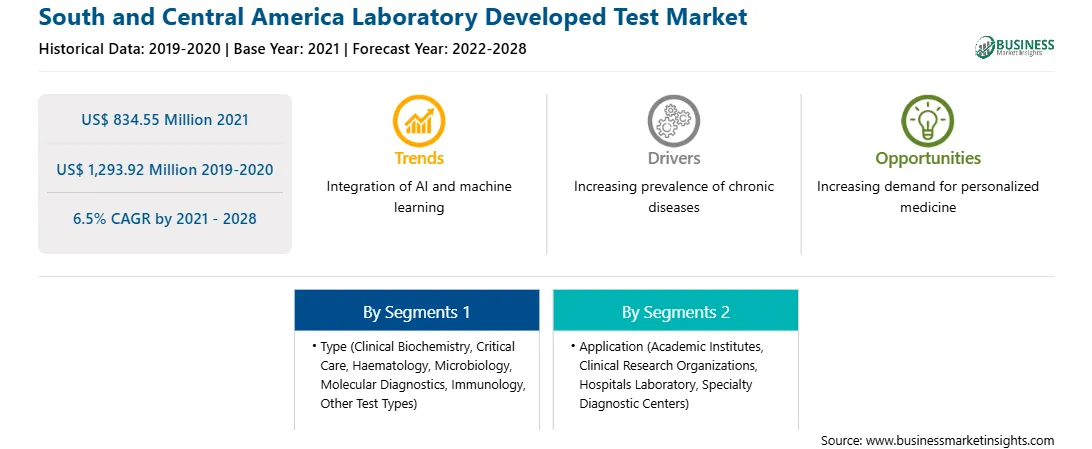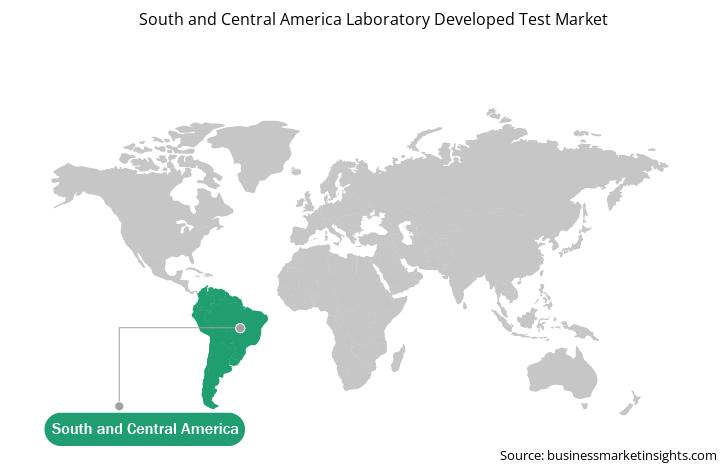A laboratory developed test (LDT) is a type of in vitro diagnostic test that is designed and used within a single laboratory. These tests can be utilized to estimate or distinguish an extensive assortment of analytes materials such as proteins, chemical compounds like glucose or cholesterol, or DNA, from a specimen received from human anatomy. The expansion of automated in vitro diagnostics (IVD) methods for labs and dispensaries to render precise, and error-free analysis is anticipated to fuel the increment.

Strategic insights for the South and Central America Laboratory Developed Test provides data-driven analysis of the industry landscape, including current trends, key players, and regional nuances. These insights offer actionable recommendations, enabling readers to differentiate themselves from competitors by identifying untapped segments or developing unique value propositions. Leveraging data analytics, these insights help industry players anticipate the market shifts, whether investors, manufacturers, or other stakeholders. A future-oriented perspective is essential, helping stakeholders anticipate market shifts and position themselves for long-term success in this dynamic region. Ultimately, effective strategic insights empower readers to make informed decisions that drive profitability and achieve their business objectives within the market.

| Report Attribute | Details |
|---|---|
| Market size in 2021 | US$ 834.55 Million |
| Market Size by 2028 | US$ 1,293.92 Million |
| Global CAGR (2021 - 2028) | 6.5% |
| Historical Data | 2019-2020 |
| Forecast period | 2022-2028 |
| Segments Covered |
By Type
|
| Regions and Countries Covered | South and Central America
|
| Market leaders and key company profiles |
The geographic scope of the South and Central America Laboratory Developed Test refers to the specific areas in which a business operates and competes. Understanding local distinctions, such as diverse consumer preferences (e.g., demand for specific plug types or battery backup durations), varying economic conditions, and regulatory environments, is crucial for tailoring strategies to specific markets. Businesses can expand their reach by identifying underserved areas or adapting their offerings to meet local demands. A clear market focus allows for more effective resource allocation, targeted marketing campaigns, and better positioning against local competitors, ultimately driving growth in those targeted areas.

The South and Central America laboratory developed test market is expected to reach US$ 1,293.92 million by 2028 from US$ 834.55 million in 2021; it is estimated to grow at a CAGR of 6.5% from 2021 to 2028. The key factors driving the market's growth are the increasing incidence of cancer and genetic disorders and the growing number of product launches for laboratory developed tests. However, the changing regulatory landscape is hampering the growth of the South and Central America laboratory development test market.
Cancer is one of the leading causes of death worldwide. As per the WHO, cancer was a cause of ~9.6 million deaths in 2018. Clinical diagnostics helps in detecting early signs and risk factors, paving the way for early intervention. The laboratory developed tests (LDTs) have a decisive impact on each step of diagnosis, from screening to the prevention of certain diseases and early diagnosis at the onset of illness. For instance, the Oncotype DX lab test is used to determine if chemotherapy would benefit patients with early-stage breast cancer. It also helps evaluate the likelihood of disease recurrence; the test is performed on a small tissue sample removed during breast cancer surgery. In addition, the increasing incidence of genetic disorders is also driving the demand for LDTs. Many LDTs are available for genetic testing due to a lack of availability of genetic tests in the market. As per the Association for Molecular Pathology 2018 assessment, ~70,000 genetic tests are available in the medical market, and most of these are LDTs. Therefore, the rising incidence of cancer and growing awareness regarding the importance of early diagnostics are boosting the adoption of LDTs. Also, LDTs are developed and used within laboratories and are not distributed or sold to other laboratories or healthcare facilities. Thus, the frequency of development and introduction of new LDTs is high. Additionally, the increasing emergence of SARS-CoV-2 variants has highlighted the need to identify, trace, and track mutations across the complete viral genome. Hence, increasing research on developing LDTs to detect cancer and autoimmune diseases is driving the market growth.
The COVID? 19 pandemic is a critical test for the already overburdened and underfunded public healthcare systems of South and Central America. State-run hospitals and clinics are already overstressed by the treatment of vector?borne diseases, community?acquired infections, and high rates of non?communicable diseases (NCDs). As per the Pan American Health Organization (PAHO), the prevention and treatment of NCDs have been critically affected since the onset of the COVID-19 in the region. Moreover, in South and Central America, the gross domestic product (GDP) and central government healthcare expenditure are significantly lower in developed countries. The increasing COVID-19 cases have severely disrupted the care for many chronic diseases, thereby hindering market growth in the region.
The South and Central America laboratory developed test market, by type, is segmented into clinical biochemistry, critical care, haematology, microbiology, molecular diagnostics, immunology, and other test types. The haematology segment is sub-segmented into coagulation and hemostasis, hemoglobin testing, blood count testing, and others. The molecular diagnostics segment is expected to hold the largest market share in 2021. However, the haematology segment is anticipated to register the highest CAGR during the forecast period.
The South and Central America laboratory developed test market, by application, is segmented into academic institutes, clinical research organizations, hospitals laboratory, specialty diagnostic centers, and others. The hospitals laboratory segment is expected to hold the largest market share in 2021. However, the specialty diagnostic centers segment is anticipated to register the highest CAGR during the forecast period.
The South and Central America Laboratory Developed Test Market is valued at US$ 834.55 Million in 2021, it is projected to reach US$ 1,293.92 Million by 2028.
As per our report South and Central America Laboratory Developed Test Market, the market size is valued at US$ 834.55 Million in 2021, projecting it to reach US$ 1,293.92 Million by 2028. This translates to a CAGR of approximately 6.5% during the forecast period.
The South and Central America Laboratory Developed Test Market report typically cover these key segments-
The historic period, base year, and forecast period can vary slightly depending on the specific market research report. However, for the South and Central America Laboratory Developed Test Market report:
The South and Central America Laboratory Developed Test Market is populated by several key players, each contributing to its growth and innovation. Some of the major players include:
The South and Central America Laboratory Developed Test Market report is valuable for diverse stakeholders, including:
Essentially, anyone involved in or considering involvement in the South and Central America Laboratory Developed Test Market value chain can benefit from the information contained in a comprehensive market report.